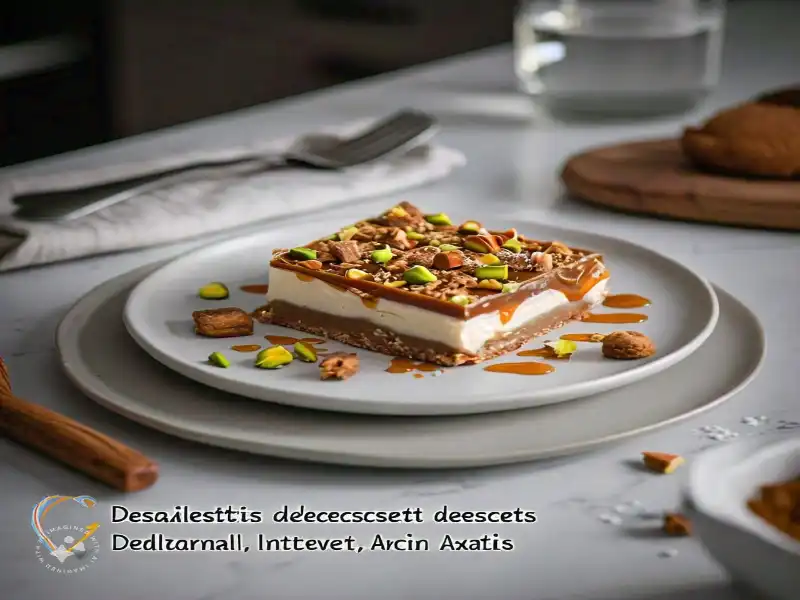Discover a world of mouthwatering diabetic dessert recipes that use natural sweeteners instead of artificial ones. Explore fruit-based treats, decadent chocolate delights, and nutritious dessert ideas for a guilt-free indulgence.
Living with diabetes doesn’t mean you have to deprive yourself of sweet treats. In fact, by embracing natural sweeteners and following diabetic dessert recipes, you can enjoy delicious desserts without compromising your health. In this blog post, we’ll explore the benefits of desserts without artificial sweeteners, introduce you to natural sweeteners, and provide a variety of diabetic-friendly dessert recipes to tantalize your taste buds.
Benefits of Diabetic Dessert Recipes without Artificial Sweeteners
When it comes to managing diabetes, finding alternatives to traditional desserts can be a challenge. Artificial sweeteners are often used as a substitute, but they may not be the healthiest option. Thankfully, diabetic dessert recipes without artificial sweeteners offer a range of benefits that can help individuals with diabetes better manage their condition while still enjoying delicious treats.
Lower Risk of Blood Sugar Spikes
One of the key benefits of diabetic dessert recipes without artificial sweeteners is a lower risk of blood sugar spikes. Artificial sweeteners can still impact blood sugar levels to some extent, whereas natural sweeteners have a gentler effect. By using alternatives like stevia, monk fruit, or erythritol, individuals with diabetes can enjoy desserts without worrying about sudden glucose spikes.
Improved Diabetes Management
Diabetic dessert recipes without artificial sweeteners can help individuals better manage their diabetes. By reducing the consumption of processed sweeteners and opting for natural alternatives, it becomes easier to regulate blood sugar levels. This can lead to better diabetes control, improved insulin sensitivity, and a reduced risk of complications associated with the condition.
Healthier Alternative to Traditional Desserts
Another advantage of diabetic dessert recipes without artificial sweeteners is that they provide a healthier alternative to traditional desserts. Traditional desserts are often high in refined sugars, unhealthy fats, and empty calories. However, by using natural sweeteners and incorporating nutrient-rich ingredients, diabetic-friendly desserts can be both indulgent and nutritious at the same time.
Exploring Natural Sweeteners for Diabetic Dessert Recipes
To make diabetic desserts more enjoyable and flavorful, it’s important to explore natural sweeteners. Some popular options include stevia, monk fruit, and erythritol. These sweeteners have little to no impact on blood sugar levels, making them suitable for individuals with diabetes. They can be used in various forms: liquid, powdered, or granulated, and can be substituted for sugar in most recipes.
Understanding Their Impact on Blood Sugar Levels
While natural sweeteners have less impact on blood sugar levels compared to artificial sweeteners or sugar, it’s still important to use them in moderation. Understanding the glycemic index (GI) and glycemic load (GL) of different sweeteners is crucial for managing blood sugar levels effectively. Some natural sweeteners may have a higher GI or GL, so it’s important to consider this when incorporating them into recipes.
Tips for Substituting Artificial Sweeteners with Natural Options
When substituting artificial sweeteners with natural options, it’s helpful to keep a few tips in mind. First, start by reducing the amount of sweetener used and gradually adjust to taste. Natural sweeteners tend to have a sweeter taste, so a smaller quantity may be sufficient. It’s also important to note that some natural sweeteners can have a slight aftertaste, so experimenting with different brands or combinations may be necessary to find the right balance.
Delicious Fruit-Based Diabetic Dessert Recipes
Fruit-based desserts are a fantastic option for those with diabetes. Fruits provide natural sweetness while offering an array of essential vitamins, minerals, and fiber. Here are a few recipes to try:
- Berry Bliss Parfait: A refreshing combination of mixed berries and yogurt. Layer the berries and yogurt in a glass, and top with a sprinkle of nuts or seeds for added crunch.
- Baked Apple Delight: A warm and comforting dessert with natural sweetness. Core an apple, fill it with a mixture of cinnamon, nuts, and a touch of natural sweetener, then bake until tender.
- Citrus Sorbet: A zesty and tangy treat for hot summer days. Blend fresh citrus juice with a natural sweetener, freeze, and churn in an ice cream maker for a refreshing sorbet.
Indulgent Chocolate Desserts with Diabetic-Friendly Sweeteners
Who says individuals with diabetes can’t enjoy chocolate? With the help of diabetic-friendly sweeteners, chocolate desserts can still be incredibly indulgent and satisfying. Try these recipes:
- Decadent Dark Chocolate Mousse: A rich and creamy dessert without added sugars. Combine dark chocolate, avocado, and a natural sweetener in a food processor until smooth and velvety. Refrigerate for a few hours before serving.
- Keto Chocolate Truffles: Bite-sized delights made with sugar alternatives. Mix together unsweetened cocoa powder, almond flour, a natural sweetener, and a hint of vanilla extract. Shape into small balls, roll in cocoa powder, and refrigerate until firm.
- Flourless Chocolate Cake: A gluten-free option with intense chocolate flavor. Combine dark chocolate, eggs, butter, and a natural sweetener. Bake until set and delight in a moist and decadent treat.
Nutritious Dessert Ideas for Diabetics
Incorporating nutritious ingredients into desserts can enhance their health benefits. Here are some ideas for nutritious diabetic-friendly desserts:
- Chia Seed Pudding: A fiber-rich and satisfying dessert with minimal sugars. Soak chia seeds in your choice of milk, add a natural sweetener, and allow to thicken overnight. Top with fresh berries or nuts for added texture.
- Avocado Chocolate Mousse: A creamy and healthy alternative to traditional mousse. Blend ripe avocado, cocoa powder, a natural sweetener, and a touch of vanilla extract until smooth. Refrigerate until chilled and serve.
- Frozen Banana Bites: An easy-to-make frozen treat with natural fruit sweetness. Slice ripe bananas into bite-sized pieces, dip halfway into melted dark chocolate, and freeze until solid.
Exploring Alternative Flours for Diabetic Dessert Recipes
Traditional flours can be high in carbohydrates, which can impact blood sugar levels. Exploring alternative flours allows individuals with diabetes to enjoy baked goods without the glucose rollercoaster. Here’s an introduction to some alternative flours and a few recipe ideas:
Almond Flour, Coconut Flour, and Other Low-Carb Options
Almond flour and coconut flour are two popular low-carb alternatives to traditional wheat flour. They are gluten-free, low in carbohydrates, and higher in fiber and healthy fats. Other low-carb options include flours made from legumes, such as chickpea flour, or seed flours, like flaxseed meal.
Recipes for Diabetic-Friendly Cakes, Cookies, and Muffins Using Alternative Flours
With alternative flours, individuals with diabetes can still enjoy their favorite baked goods. Consider these recipes as a starting point:
- Almond Flour Blueberry Muffins: Combine almond flour, natural sweetener, eggs, and fresh blueberries for a delightful and fluffy muffin.
- Coconut Flour Chocolate Chip Cookies: Use coconut flour, coconut oil, a natural sweetener, and sugar-free chocolate chips to make delicious cookies with a delightful coconut flavor.
- Chickpea Flour Pancakes: Substitute chickpea flour in your go-to pancake recipe for a protein-packed alternative that can help stabilize blood sugar levels.
Tips for Successful Baking with Alternative Flours
When baking with alternative flours, a few tips can ensure successful results. First, alternative flours often require additional moisture, so recipes may call for more liquid ingredients like eggs or milk. It’s also important to follow specific instructions for each flour, as ratios may differ from wheat flour. And don’t be discouraged if the texture or taste varies slightly from traditional recipes – that’s part of the charm of using alternative flours.
Tips for Incorporating Diabetic Desserts into a Balanced Diet
While diabetic desserts without artificial sweeteners can be a healthier option, moderation is still key. Here are some tips for incorporating diabetic-friendly desserts into a balanced diet:
- Portion Control and Moderation: It’s vital to practice portion control when enjoying desserts. This helps prevent blood sugar spikes and keeps overall caloric intake in check.
- Combining with Protein and Healthy Fats: Pairing desserts with protein and healthy fats can help slow down digestion and minimize the impact on blood sugar levels. For example, enjoy a serving of Greek yogurt or a handful of nuts alongside a dessert.
- Consulting with a Healthcare Professional: For personalized guidance on incorporating diabetic desserts into a balanced diet, consult with a healthcare professional, such as a registered dietitian or diabetes educator. They can provide specific recommendations based on individual needs and goals.
Conclusion
Diabetic dessert recipes without artificial sweeteners offer a range of benefits for individuals with diabetes. From lowering the risk of blood sugar spikes to improving diabetes management, these desserts present a healthier alternative to traditional options. By exploring natural sweeteners, fruit-based treats, indulgent chocolate desserts, and recipes using alternative flours, individuals can enjoy a variety of delicious diabetic-friendly desserts while maintaining a balanced and enjoyable lifestyle. So, dive into the marvelous world of diabetic desserts without hesitation and savor the joys of natural sweetness.

